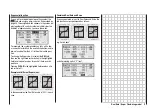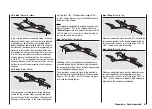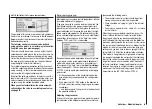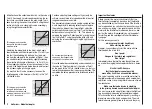
71
Heli mixer – Model helicopter
The basic set-up procedure
Although the mx-16s transmitter provides a broad ran-
ge of adjustment for the collective pitch and throttle cur-
ves, it is essential that you fi rst adjust all the mechani-
cal linkages in the model according to the information
supplied by the helicopter manufacturer, i.e. all the sys-
tem linkages should already be approximately correct in
mechanical terms. If you are not sure of this, an expe-
rienced helicopter pilot will be glad to help you with this
basic set-up.
The throttle linkage must be adjusted in such a way that
the throttle is just at the “fully open” position at the full-
throttle setting. When the throttle limiter is at the idle po-
sition, the C1 trim lever should just be able to close the
throttle completely, without the servo striking its mecha-
nical end-stop (quick throttle adjustment using the “digi-
tal trim”: see page 26).
Take your time, and carry out these adjustments very
carefully by adjusting the mechanical linkage and / or
changing the linkage point on the servo output arm or
the throttle lever. Only when you are confi dent that all
is well should you start optimising and fi ne-tuning the
throttle servo using the transmitter’s electronic facilities.
Caution:
Read all you can about motors and helicopters, so
that you are aware of the inherent dangers and the
cautionary measures required before you attempt to
start the motor for the fi rst time!
With the basic set-up completed, it should be pos-
sible to start the motor in accordance with the opera-
ting instructions supplied with it, and adjust the idle set-
ting using the trim lever of the throttle / collective pitch
stick. The idle position which you set is indicated in the
transmitter’s basic screen display by a horizontal bar
in the display of the C1 trim lever’s position. Refer to
page 26 of this manual for a full explanation of the digi-
tal trims.
Approximately at the mid-point of the collective pitch
stick the model should lift off the ground and hover at
the rotational speed you wish to use. If this is not the
case, correct the settings as follows:
1. The model does not lift off until the collective
pitch stick is above the centre point.
a) Rotational speed too low
Remedy: increase the value
for the throttle servo parameter
at Point 3 of the stick travel in
the
“Ch1
throttle
” mixer, as
shown in the graph.
b) Rotational speed too high
Remedy: increase the blade
pitch angle for collective pitch
at Point 3 of the stick travel in
the
“Ch1
collective pitch
curve”
menu, as shown in the
graph.
2. The model lifts off below the centre point.
a) Rotational speed too high
Remedy: reduce the throttle
opening in the
“Ch1
thrott-
le”
mixer at Point 3 of the stick
travel, as shown in the graph..
Important:
You should persevere with this adjustment procedure
until the model hovers at the correct rotational speed at
the centre point of the throttle / collective pitch stick. All
the other model settings depend upon the correct setting
of these parameters!
The standard set-up
The remainder of the standard adjustment procedu-
re is completed on the basis of the fundamental set-up
which you have just carried out, i.e. we now assume that
the model hovers in normal fl ight at the centre point of
the throttle / collective pitch stick, with the correct rotor
speed. This means that your model helicopter is capab-
le of hovering and also fl ying circuits in all phases whilst
maintaining a constant system rotational speed.
The climb setting
The combination of throttle hover setting, collective pitch
setting for the hover and the maximum collective pitch
setting (Point 5) now provides you with a simple method
of achieving constant system rotational speed from the
hover right to maximum climb.
Start by placing the model in an extended vertical climb,
holding the collective pitch stick at its end-point: motor
speed should not alter compared with the hover setting.
If motor speed falls off in the climb, when the throttle is
already fully open and no further power increase is pos-
sible (this assumes that the motor is correctly adjusted),
then you should reduce maximum blade pitch angle at
b) Rotational speed too low
Remedy: reduce the blade
pitch angle for collective pitch
at Point 3 of the stick travel in
the
“Ch1
collective pitch
curve”
, as shown in the graph.
H o v e r
P o i n t
1 2 3 4 5
C o n t r o l T r a v e l
O
u
tp
u
t
+ 1 0 0 %
- 1 0 0 %
H o v e r
P o i n t
1 2 3 4 5
C o n t r o l T r a v e l
O
u
tp
u
t
+ 1 0 0 %
- 1 0 0 %
H o v e r
P o i n t
1 2 3 4 5
C o n t r o l T r a v e l
O
u
tp
u
t
+ 1 0 0 %
- 1 0 0 %
H o v e r
P o i n t
1 2 3 4 5
C o n t r o l T r a v e l
O
u
tp
u
t
+ 1 0 0 %
- 1 0 0 %
Summary of Contents for MX-16S
Page 1: ...1...
Page 17: ...17...
Page 31: ...31 Fixed wing models Installation and connections...
Page 35: ...35 Program description Reserving a new memory...
Page 47: ...47 Base settings Model helicopter...
Page 83: ...83 Fail safe...
Page 89: ...89 Programming examples Fixed wing model...
Page 109: ...109 Programming examples Model helicopter...
Page 112: ...112 112...
Page 116: ...116...
















































